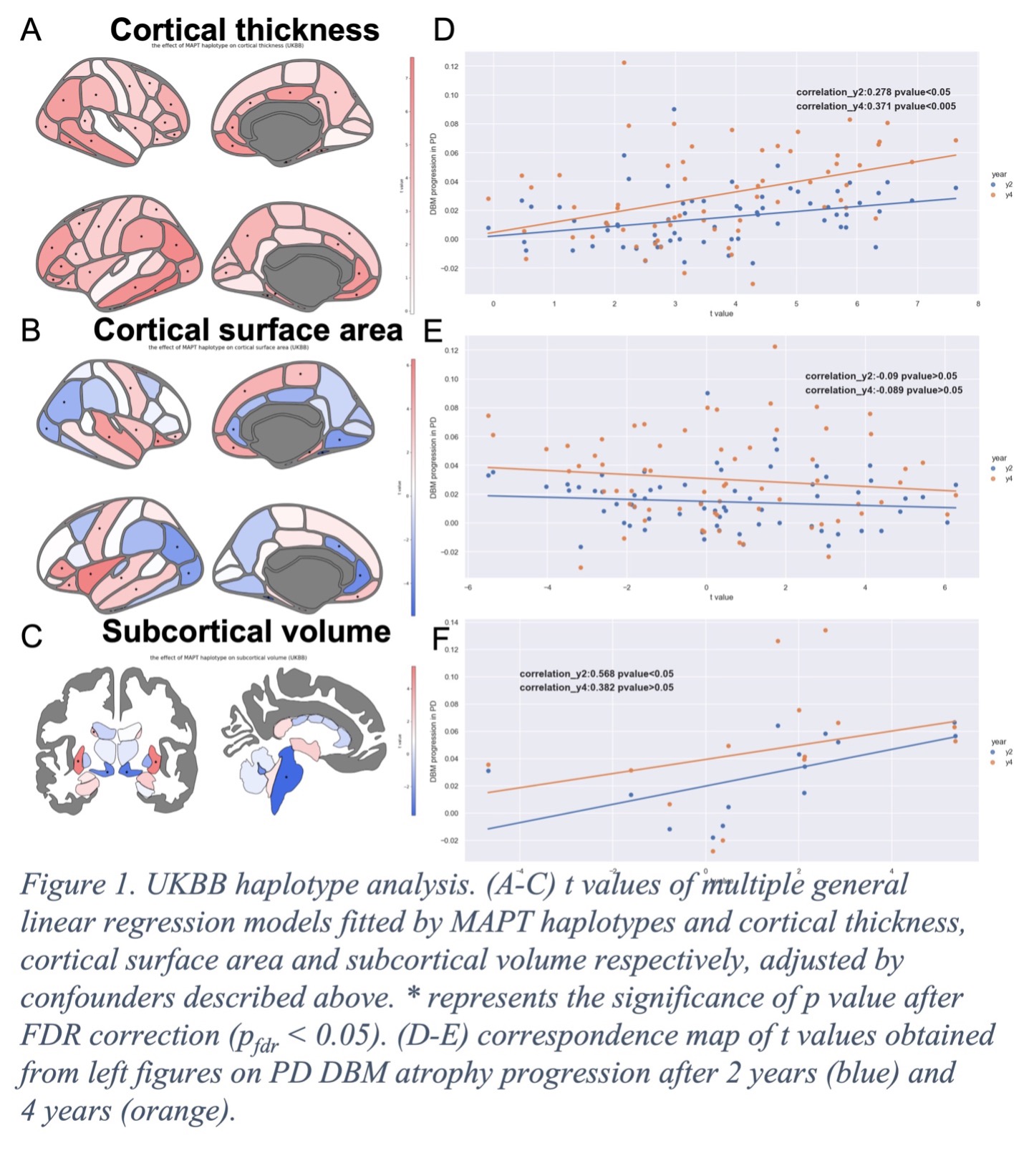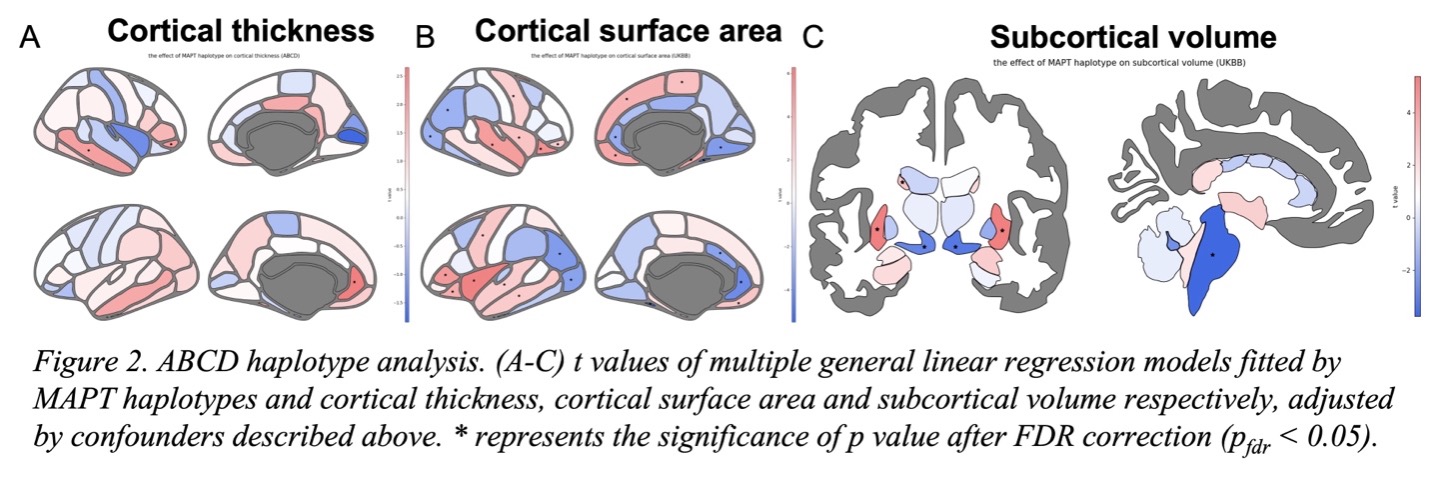Category: Parkinson's Disease: Genetics
Objective: To investigate if the vulnerability of Parkinson’s Disease (PD) can be reflected in the neuroanatomical structure in different MAPT haplotype carriers.
Background: It has been demonstrated that MAPT haplotypes can influence the risk of tauopathies and synucleinopathies such as Parkinson’s disease (PD)1. Among people with PD, carriers of the MAPT haplotype H1 have a higher risk of accelerated progression to dementia, poor cognitive performance and more severe non-tremor dominant phenotype than MAPT haplotype H2 carriers2,3,4. In addition, neuroimaging studies of PD have shown that there is significant loss of volume in cortical and subcortical regions compared with healthy controls.5
Method: MAPT haplotypes and neuroimaging data were derived from UK Biobank (UKBB) and the Adolescent Brain Cognitive Development (ABCD)6,7. 30716 unrelated European older adults in UKBB and 4403 adolescent individuals in ABCD were included in the analysis. We performed a haplotype analysis of MAPT, where H1 and H2 haplotypes were derived by the genotype of SNP rs10525538. We then compared haplotype status with structural MRI data including cortical thickness, cortical surface area and subcortical volume by fitting multiple general linear models for each region, while considering a regional measurement as the dependent and MAPT haplotype as the independent variable.
Results: An increased total cortical surface area, a reduced global cortical thickness and a decreased putamen volume were significantly associated with the presence of the MAPT haplotype H1.
We next investigated if there was a MAPT-expression-specific distribution of the haplotype effect: significant correlations were found between PD DBM atrophy progression and t values obtained from the models fitted by subcortical volumes and MAPT haplotypes.
The haplotype analyses described above were replicated in ABCD. Significant associations were also detected in many regions.
Conclusion: The results from UKBB suggested that MAPT H1 carriers which has a higher risk in PD tend to have a thinner cortex increased cortical surface area in several brain regions, and a smaller putamen in both hemispheres. In ABCD, significant association of a reduced thickness and volume in several cortical regions and putamen respectively with MAPT H1 carriers implies that the influence of MAPT haplotype starts before adolescence.
References: 1. Zhang, Cheng-Cheng et al. “The Role of MAPT in Neurodegenerative Diseases: Genetics, Mechanisms and Therapy.” Molecular neurobiology vol. 53,7 (2016): 4893-904. doi:10.1007/s12035-015-9415-8
2. Setó-Salvia, Núria et al. “Dementia risk in Parkinson disease: disentangling the role of MAPT haplotypes.” Archives of neurology vol. 68,3 (2011): 359-64. doi:10.1001/archneurol.2011.17
3. Morley, James F et al. “Genetic influences on cognitive decline in Parkinson’s disease.” Movement disorders : official journal of the Movement Disorder Society vol. 27,4 (2012): 512-8. doi:10.1002/mds.24946
4. Di Battista, Maria Elena et al. “Clinical subtypes in Parkinson’s disease: the impact of MAPT haplotypes.” Journal of neural transmission (Vienna, Austria : 1996) vol. 121,4 (2014): 353-6. doi:10.1007/s00702-013-1117-7
5. Laansma, Max A et al. “International Multicenter Analysis of Brain Structure Across Clinical Stages of Parkinson’s Disease.” Movement disorders : official journal of the Movement Disorder Society vol. 36,11 (2021): 2583-2594. doi:10.1002/mds.28706
6. Sudlow, Cathie et al. “UK biobank: an open access resource for identifying the causes of a wide range of complex diseases of middle and old age.” PLoS medicine vol. 12,3 e1001779. 31 Mar. 2015, doi:10.1371/journal.pmed.1001779
7. Casey, B J et al. “The Adolescent Brain Cognitive Development (ABCD) study: Imaging acquisition across 21 sites.” Developmental cognitive neuroscience vol. 32 (2018): 43-54. doi:10.1016/j.dcn.2018.03.001
8. Wider, C et al. “Association of the MAPT locus with Parkinson’s disease.” European journal of neurology vol. 17,3 (2010): 483-6. doi:10.1111/j.1468-1331.2009.02847.x
To cite this abstract in AMA style:
E. Yu, C. Tremblay, A. Vo, Y. Sosero, Z. Gan-Or, A. Dagher, L. Liu (). Investigate the association of MAPT haplotype and neuroanatomical structure and its influence on the risk of Parkinson’s disease [abstract]. Mov Disord. 2023; 38 (suppl 1). https://www.mdsabstracts.org/abstract/investigate-the-association-of-mapt-haplotype-and-neuroanatomical-structure-and-its-influence-on-the-risk-of-parkinsons-disease/. Accessed December 29, 2025.« Back to 2023 International Congress
MDS Abstracts - https://www.mdsabstracts.org/abstract/investigate-the-association-of-mapt-haplotype-and-neuroanatomical-structure-and-its-influence-on-the-risk-of-parkinsons-disease/


